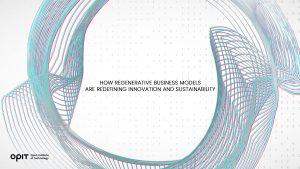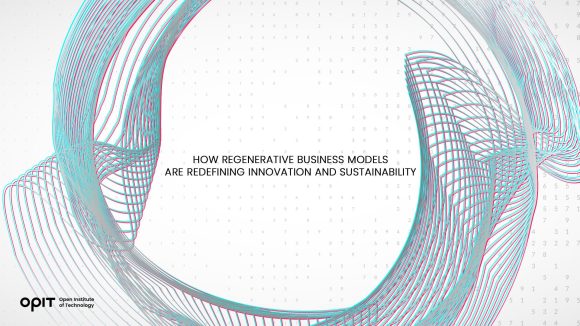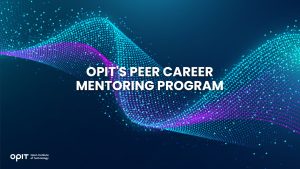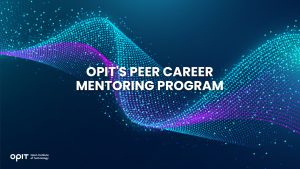

Open Institute of Technology (OPIT) masterclasses bring students face-to-face with real-world business challenges. In OPIT’s July masterclass, OPIT Professor Francesco Derchi and Ph.D. candidate Robert Mario de Stefano explained the principles of regenerative businesses and how regeneration goes hand in hand with growth.
Regenerative Business Models
Professor Derchi began by explaining what exactly is meant by regenerative business models, clearly differentiating them from sustainable or circular models.
Many companies pursue sustainable business models in which they offset their negative impact by investing elsewhere. For example, businesses that are big carbon consumers will support nature regeneration projects. Circular business models are similar but are more focused on their own product chain, aiming to minimize waste by keeping products in use as long as possible through recycling. Both models essentially aim to have a “net-zero” negative impact on the environment.
Regenerative models are different because they actively aim to have a “net-positive” impact on the environment, not just offsetting their own use but actively regenerating the planet.
Massive Transformative Purpose
While regenerative business models are often associated with philanthropic endeavors, Professor Derchi explained that they do not have to be, and that investment in regeneration can be a driver of growth.
He discussed the importance of corporate purpose in the modern business space. Having a strong and clearly stated corporate purpose is considered essential to drive business decision-making, encourage employee buy-in, and promote customer loyalty.
But today, simple corporate missions, such as “make good shoes,” don’t go far enough. People are looking for a Massive Transformational Purpose (MTP) that can take the business to the next level.
Take, for example, Ben & Jerry’s. The business’s initial corporate purpose may have been to make great ice cream and serve it up in a way that people will enjoy. But the business really began to grow when they embraced an MTP. As they announced in their mission statement, “We believe that ice cream can change the world.” Their business activities also have the aim of advancing human rights and dignity, supporting social and economic justice, and protecting and restoring the Earth’s natural systems. While these aims are philanthropic, they have also helped the business grow.
RePlanet
Professor Derchi next talked about RePlanet, a business he recently worked to develop their MTP. Founded in 2015, RePlanet designs and implements customized renewable energy solutions for businesses and projects. The company already operates in the renewable energy field and ranked as the 21st fastest-growing business in Italy in 2023. So while they were already enjoying great success, Derchi worked with them to see if actively embracing a regenerative business model could unlock additional growth.
Working together, RePlanet moved towards an MTP of building a greener future based on today’s choices, ensuring a cleaner world for generations. Meeting this goal started with the energy products that RePlanet sells, such as energy systems that recover heat from dairy farms. But as the business’s MTP, it goes beyond that. RePlanet doesn’t just engage suppliers; it chooses partners that share its specific values. It also influences the projects they choose to work on – they prioritize high-impact social projects, such as recently installing photovoltaic energy systems at a local hospital in Nigeria – and how RePlanet treats its talent, acknowledging that people are the true energy of the company.
Regenerative Business Strategies
Based on work with RePlanet and other businesses, Derchi has identified six archetypal regenerative business strategies for businesses that want to have both a regenerative impact and drive growth:
- Regenerative Leadership – Laying the foundation for regeneration in a broader sense throughout the company
- Nature Regeneration – Strategies to improve the health of the natural world
- Social Regeneration – Regenerating human ecosystems through things such as fair-trade practices
- Responsible Sourcing – Empowering and strengthening suppliers and their communities
- Health & Well-being – Creating products and services that have a positive effect on customers
- Employee Focus – Improve work conditions, lives, and well-being of employees.
Case Studies
Building on the concept of regenerative business models, Roberto Mario de Stefano shared other case studies of businesses that are having a positive impact and enjoying growth thanks to regenerative business models and strategies.
Biorfarm
Biorfarm is a digital platform that supports small-scale agriculture by creating a direct link between small farmers and consumers. Cutting out the middleman in modern supply chains means that farmers earn about 50% more for their produce. They set consumers up as “digital farmers” who actively support and learn about farming activities to promote more conscious food consumption.
Their vision is to create a food economy in which those who produce food and those who consume it are connected. This moves consumers from passive cash cows for large corporations that prioritize profits over the well-being of farmers to actively supporting natural production and a more sustainable system.
Rifo Lab
Rifo Lab is a circular clothing brand with the vision of addressing the problem of overproduction in the clothing industry. Established in Prato, Italy, a traditional textile-producing area, the company produces clothes made from textile waste and biodegradable materials. There are no physical stores, and all orders must be placed online; everything is made to order, reducing excess production.
With an eye on social regeneration, all production takes place within 30 kilometers of their offices, allowing the business to support ethical and local production. They also work with companies that actively integrate migrants into the local community, sharing their local artisan crafts with future generations.
Ogyre
Ogyre is a digital platform that allows you to pay fishermen to fish for waste. When fishermen are out conducting their livelihood, they also collect a significant amount of waste from the ocean, especially plastic waste. Ogyre arranges for fishermen to get paid for collecting that waste, which in turn supports the local fishing communities, and then transforms the waste collected into new sustainable products.
Moving Towards a Regenerative Future
The masterclass concluded with a Q&A session, where it explained that working in regenerative businesses requires the same skills as any other business. But it also requires you to embrace a mindset where value comes from giving and that growth is about working together for a better future, and not just competition.
Related posts

Source:
- Raconteur, published on November 06th, 2025
Many firms have conducted successful Artificial Intelligence (AI) pilot projects, but scaling them across departments and workflows remains a challenge. Inference costs, data silos, talent gaps and poor alignment with business strategy are just some of the issues that leave organisations trapped in pilot purgatory. This inability to scale successful experiments means AI’s potential for improving enterprise efficiency, decision-making and innovation isn’t fully realised. So what’s the solution?
Although it’s not a magic bullet, an AI operating model is really the foundation for scaling pilot projects up to enterprise-wide deployments. Essentially it’s a structured framework that defines how the organisation develops, deploys and governs AI. By bringing together infrastructure, data, people, and governance in a flexible and secure way, it ensures that AI delivers value at scale while remaining ethical and compliant.
“A successful AI proof-of-concept is like building a single race car that can go fast,” says Professor Yu Xiong, chair of business analytics at the UK-based Surrey Business School. “An efficient AI technology operations model, however, is the entire system – the processes, tools, and team structures – for continuously manufacturing, maintaining, and safely operating an entire fleet of cars.”
But while the importance of this framework is clear, how should enterprises establish and embed it?
“It begins with a clear strategy that defines objectives, desired outcomes, and measurable success criteria, such as model performance, bias detection, and regulatory compliance metrics,” says Professor Azadeh Haratiannezhadi, co-founder of generative AI company Taktify and professor of generative AI in cybersecurity at OPIT – the Open Institute of Technology.
Platforms, tools and MLOps pipelines that enable models to be deployed, monitored and scaled in a safe and efficient way are also essential in practical terms.
“Tools and infrastructure must also be selected with transparency, cost, and governance in mind,” says Efrain Ruh, continental chief technology officer for Europe at Digitate. “Crucially, organisations need to continuously monitor the evolving AI landscape and adapt their models to new capabilities and market offerings.”
An open approach
The most effective AI operating models are also founded on openness, interoperability and modularity. Open source platforms and tools provide greater control over data, deployment environments and costs, for example. These characteristics can help enterprises to avoid vendor lock-in, successfully align AI to business culture and values, and embed it safely into cross-department workflows.
“Modularity and platformisation…avoids building isolated ‘silos’ for each project,” explains professor Xiong. “Instead, it provides a shared, reusable ‘AI platform’ that integrates toolchains for data preparation, model training, deployment, monitoring, and retraining. This drastically improves efficiency and reduces the cost of redundant work.”
A strong data strategy is equally vital for ensuring high-quality performance and reducing bias. Ideally, the AI operating model should be cloud and LLM agnostic too.
“This allows organisations to coordinate and orchestrate AI agents from various sources, whether that’s internal or 3rd party,” says Babak Hodjat, global chief technology officer of AI at Cognizant. “The interoperability also means businesses can adopt an agile iterative process for AI projects that is guided by measuring efficiency, productivity, and quality gains, while guaranteeing trust and safety are built into all elements of design and implementation.”
A robust AI operating model should feature clear objectives for compliance, security and data privacy, as well as accountability structures. Richard Corbridge, chief information officer of Segro, advises organisations to: “Start small with well-scoped pilots that solve real pain points, then bake in repeatable patterns, data contracts, test harnesses, explainability checks and rollback plans, so learning can be scaled without multiplying risk. If you don’t codify how models are approved, deployed, monitored and retired, you won’t get past pilot purgatory.”
Of course, technology alone can’t drive successful AI adoption at scale: the right skills and culture are also essential for embedding AI across the enterprise.
“Multidisciplinary teams that combine technical expertise in AI, security, and governance with deep business knowledge create a foundation for sustainable adoption,” says Professor Haratiannezhadi. “Ongoing training ensures staff acquire advanced AI skills while understanding associated risks and responsibilities.”
Ultimately, an AI operating model is the playbook that enables an enterprise to use AI responsibly and effectively at scale. By drawing together governance, technological infrastructure, cultural change and open collaboration, it supports the shift from isolated experiments to the kind of sustainable AI capability that can drive competitive advantage.
In other words, it’s the foundation for turning ambition into reality, and finally escaping pilot purgatory for good.

The Open Institute of Technology (OPIT) is the perfect place for those looking to master the core skills and gain the fundamental knowledge they need to enter the exciting and dynamic environment of the tech industry. While OPIT’s various degrees and courses unlock the doors to numerous careers, students may not know exactly which line of work they wish to enter, or how, exactly, to take the next steps.
That’s why, as well as providing exceptional online education in fields like Responsible AI, Computer Science, and Digital Business, OPIT also offers an array of career-related services, like the Peer Career Mentoring Program. Designed to provide the expert advice and support students need, this program helps students and alumni gain inspiration and insight to map out their future careers.
Introducing the OPIT Peer Career Mentoring Program
As the name implies, OPIT’s Peer Career Mentoring Program is about connecting students and alumni with experienced peers to provide insights, guidance, and mentorship and support their next steps on both a personal and professional level.
It provides a highly supportive and empowering space in which current and former learners can receive career-related advice and guidance, harnessing the rich and varied experiences of the OPIT community to accelerate growth and development.
Meet the Mentors
Plenty of experienced, expert mentors have already signed up to play their part in the Peer Career Mentoring Program at OPIT. They include managers, analysts, researchers, and more, all ready and eager to share the benefits of their experience and their unique perspectives on the tech industry, careers in tech, and the educational experience at OPIT.
Examples include:
- Marco Lorenzi: Having graduated from the MSc in Applied Data Science and AI program at OPIT, Marco has since progressed to a role as a Prompt Engineer at RWS Group and is passionate about supporting younger learners as they take their first steps into the workforce or seek career evolution.
- Antonio Amendolagine: Antonio graduated from the OPIT MSc in Applied Data Science and AI and currently works as a Product Marketing and CRM Manager with MER MEC SpA, focusing on international B2B businesses. Like other mentors in the program, he enjoys helping students feel more confident about achieving their future aims.
- Asya Mantovani: Asya took the MSc in Responsible AI program at OPIT before taking the next steps in her career as a Software Engineer with Accenture, one of the largest IT companies in the world, and a trusted partner of the institute. With a firm belief in knowledge-sharing and mutual support, she’s eager to help students progress and succeed.
The Value of the Peer Mentoring Program
The OPIT Peer Career Mentoring Program is an invaluable source of support, inspiration, motivation, and guidance for the many students and graduates of OPIT who feel the need for a helping hand or guiding light to help them find the way or make the right decisions moving forward. It’s a program built around the sharing of wisdom, skills, and insights, designed to empower all who take part.
Every student is different. Some have very clear, fixed, and firm objectives in mind for their futures. Others may have a slightly more vague outline of where they want to go and what they want to do. Others live more in the moment, focusing purely on the here and now, but not thinking too far ahead. All of these different types of people may need guidance and support from time to time, and peer mentoring provides that.
This program is also just one of many ways in which OPIT bridges the gaps between learners around the world, creating a whole community of students and educators, linked together by their shared passions for technology and development. So, even though you may study remotely at OPIT, you never need to feel alone or isolated from your peers.
Additional Career Services Offered by OPIT
The Peer Career Mentoring Program is just one part of the larger array of career services that students enjoy at the Open Institute of Technology.
- Career Coaching and Support: Students can schedule one-to-one sessions with the institute’s experts to receive insightful feedback, flexibly customized to their exact needs and situation. They can request resume audits, hone their interview skills, and develop action plans for the future, all with the help of experienced, expert coaches.
- Resource Hub: Maybe you need help differentiating between various career paths, or seeing where your degree might take you. Or you need a bit of assistance in handling the challenges of the job-hunting process. Either way, the OPIT Resource Hub contains the in-depth guides you need to get ahead and gain practical skills to confidently move forward.
- Career Events: Regularly, OPIT hosts online career event sessions with industry experts and leaders as guest speakers about the topics that most interest today’s tech students and graduates. You can join workshops to sharpen your skills and become a better prospect in the job market, or just listen to the lessons and insights of the pros.
- Internship Opportunities: There are few better ways to begin your professional journey than an internship at a top-tier company. OPIT unlocks the doors to numerous internship roles with trusted institute partners, as well as additional professional and project opportunities where you can get hands-on work experience at a high level.
In addition to the above, OPIT also teams up with an array of leading organizations around the world, including some of the biggest names, including AWS, Accenture, and Hype. Through this network of trust, OPIT facilitates students’ steps into the world of work.
Start Your Study Journey Today
As well as the Peer Career Mentoring Program, OPIT provides numerous other exciting advantages for those who enroll, including progressive assessments, round-the-clock support, affordable rates, and a team of international professors from top universities with real-world experience in technology. In short, it’s the perfect place to push forward and get the knowledge you need to succeed.
So, if you’re eager to become a tech leader of tomorrow, learn more about OPIT today.
Have questions?
Visit our FAQ page or get in touch with us!
Write us at +39 335 576 0263
Get in touch at hello@opit.com
Talk to one of our Study Advisors
We are international
We can speak in:


